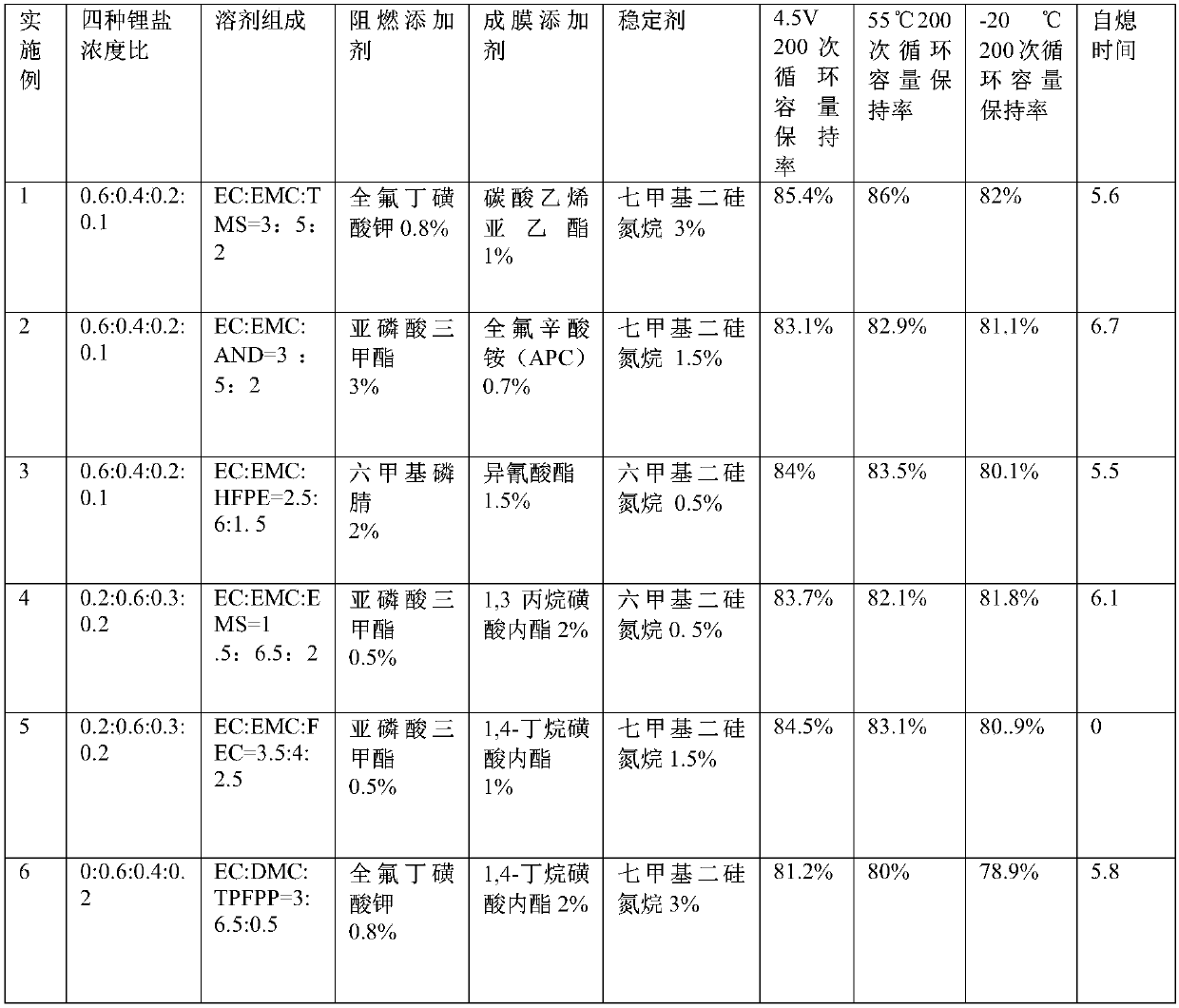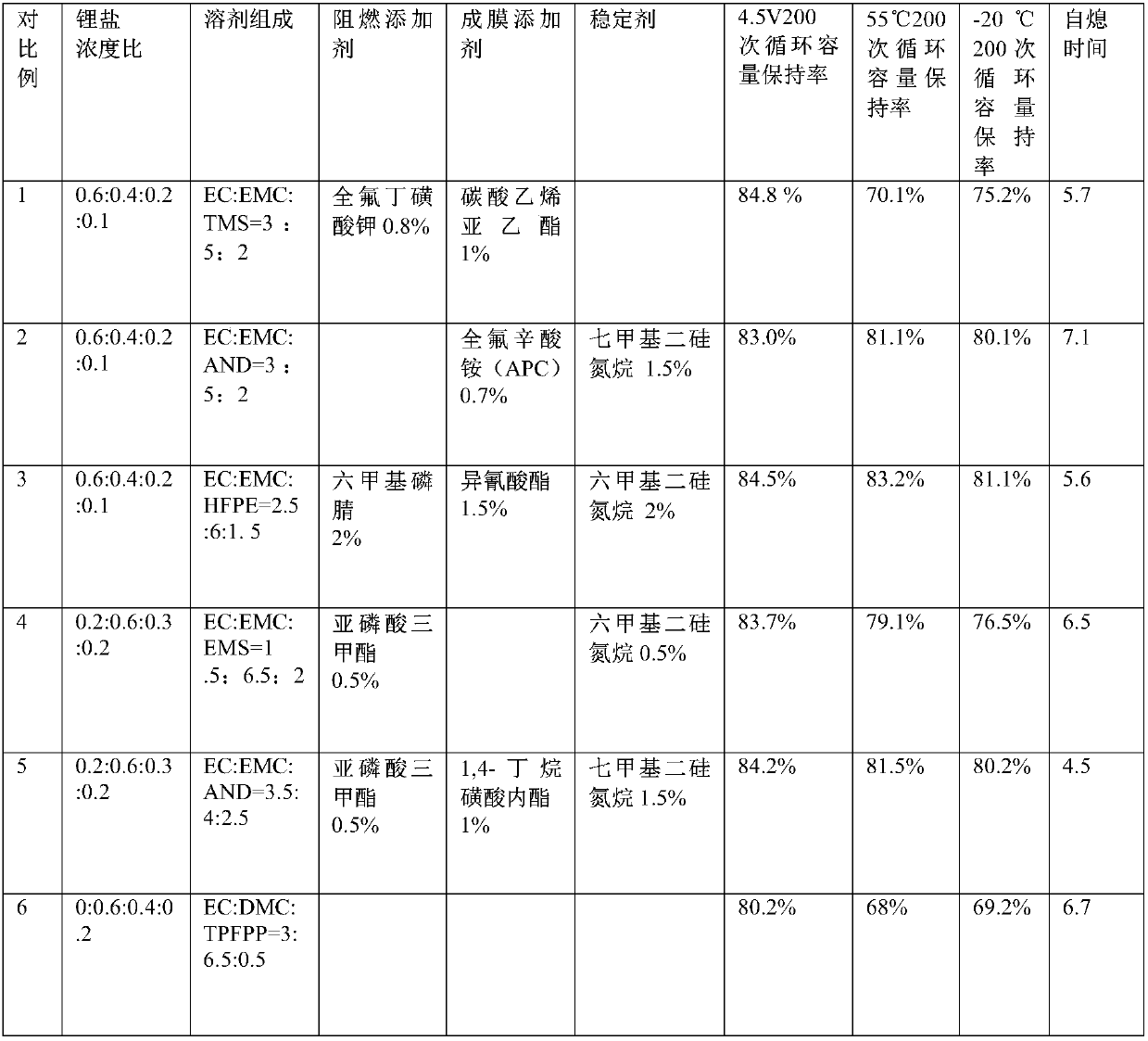Lithium ion power battery electrolyte and lithium ion secondary battery
A power battery, secondary battery technology, applied in secondary batteries, circuits, electrical components, etc., can solve problems such as poor performance, and achieve the effect of good cycle performance
- Summary
- Abstract
- Description
- Claims
- Application Information
AI Technical Summary
Problems solved by technology
Method used
Image
Examples
Embodiment 1
[0030] The electrolytic solution for a power battery provided in this embodiment includes a lithium salt mixture, a high-pressure-resistant organic solvent, a stabilizer and auxiliary additives, and the lithium salt mixture is based on lithium hexafluorophosphate (LiPF 6 ): Lithium bisfluorosulfonyl imide (LiFSI): Lithium difluorooxalate borate: Lithium difluorophosphate = 0.6:0.4:0.2:0.1 molar ratio, the lithium salt mixture accounts for 15% of the mass of the electrolyte, organic solvent Ethylene carbonate, ethyl methyl carbonate and sulfolane are mixed in a mass ratio of 3:5:2, and the organic solvent accounts for 80.2% of the mass of the electrolyte. The flame retardant is potassium perfluorobutanesulfonate (PNB), which accounts for 0.8% of the electrolyte mass, and the positive and negative electrode film-forming additives are ethylene carbonate (VEC), which accounts for 1% of the electrolyte mass, The stabilizer is heptamethyldisilazane, which accounts for 3% of the mass...
Embodiment 2
[0034] The electrolytic solution for a power battery provided in this embodiment includes a lithium salt mixture, a high-pressure-resistant organic solvent, a stabilizer and auxiliary additives, and the lithium salt mixture is based on lithium hexafluorophosphate (LiPF 6 ): bisfluorosulfonimide Lithium (LiFSI): lithium difluorooxalate borate: lithium difluorophosphate = 0.6:0.4:0.2:0.1 molar ratio to form a lithium salt mixture accounting for 15% of the mass of the electrolyte. Described organic solvent is that propylene carbonate, dimethyl carbonate, adiponitrile are mixed with the ratio of 3:5:2 in mass ratio, and the 79.8% flame retardant that organic solvent accounts for electrolyte quality is trimethyl phosphite, It accounts for 3% of the mass of the electrolyte, the positive and negative film-forming additives are ammonium perfluorooctanoate (APC), which accounts for 0.7% of the mass of the electrolyte, and the stabilizer is heptamethyldisilazane, which accounts for 0.7% ...
Embodiment 3
[0038] The electrolytic solution for a power battery provided in this embodiment includes a lithium salt mixture, a high-voltage resistant organic solvent, a stabilizer and auxiliary additives, and the lithium salt mixture is made of lithium hexafluorophosphate (LiPF 6 ): Lithium bisfluorosulfonyl imide (LiFSI): Lithium difluorooxalate borate: Lithium difluorophosphate=0.6:0.4:0.2:0.1 molar ratio composition The lithium salt mixture accounts for 15% of the mass of the electrolyte. The organic solvent is a mixed solvent mixed with ethylene carbonate, diethyl carbonate and hexafluoroisopropyl ethyl ether in a mass ratio of 2.5:6:1.5, the organic solvent accounts for 81% of the mass of the electrolyte, and the flame retardant is hexamethylphosphorus Nitrile, which accounts for 2% of the mass of the electrolyte, positive and negative film-forming additives are isocyanates, which account for 1.5% of the mass of the electrolyte, stabilizers are hexamethyldisilazane, which account for...
PUM
 Login to View More
Login to View More Abstract
Description
Claims
Application Information
 Login to View More
Login to View More - R&D
- Intellectual Property
- Life Sciences
- Materials
- Tech Scout
- Unparalleled Data Quality
- Higher Quality Content
- 60% Fewer Hallucinations
Browse by: Latest US Patents, China's latest patents, Technical Efficacy Thesaurus, Application Domain, Technology Topic, Popular Technical Reports.
© 2025 PatSnap. All rights reserved.Legal|Privacy policy|Modern Slavery Act Transparency Statement|Sitemap|About US| Contact US: help@patsnap.com


